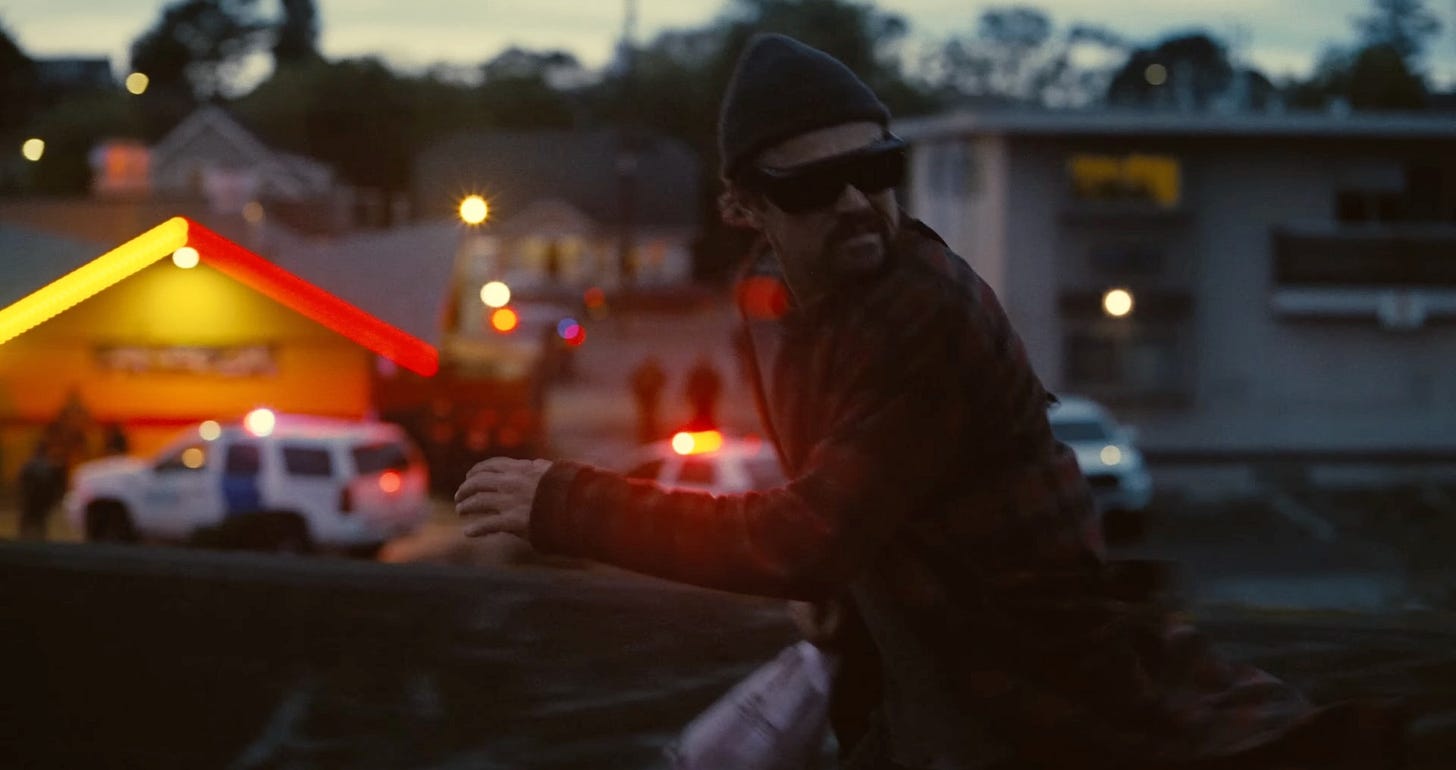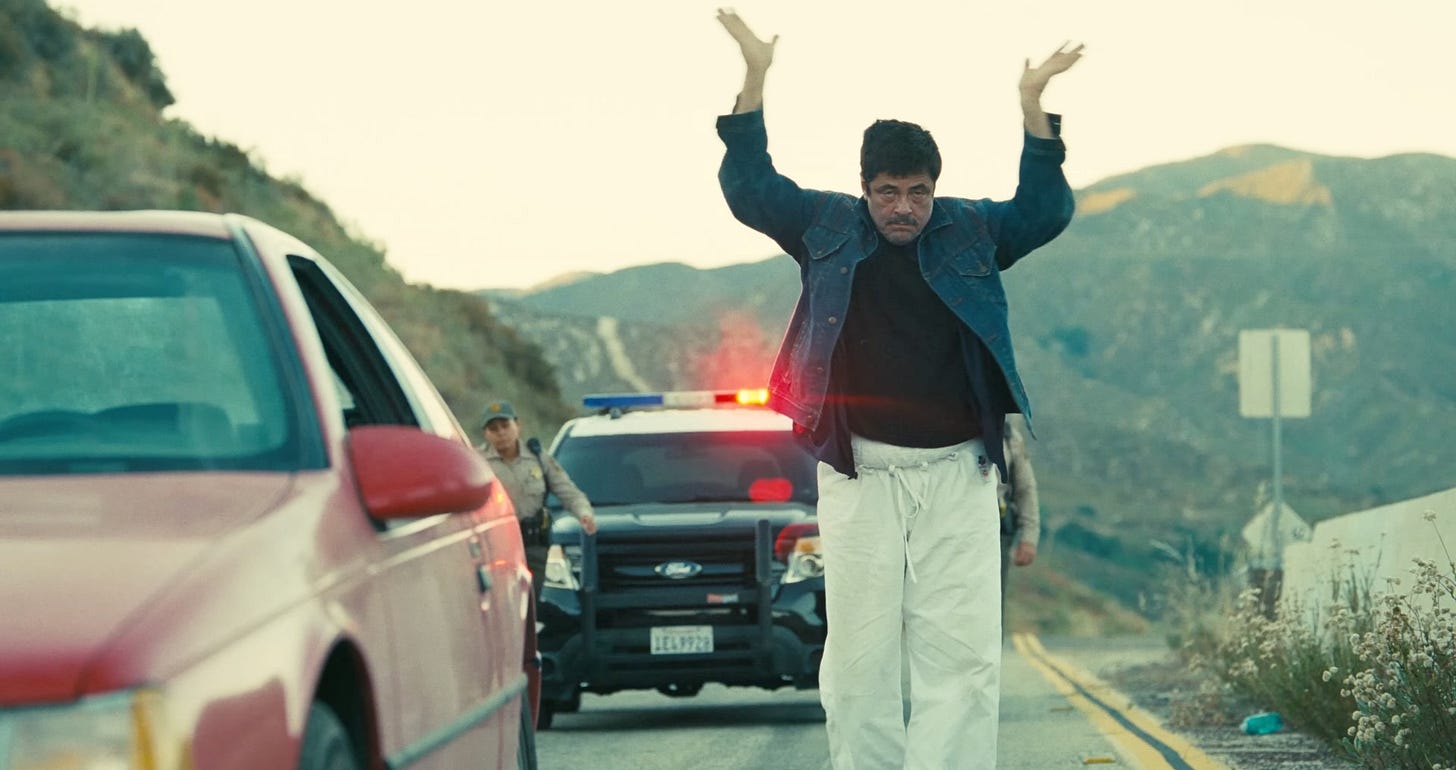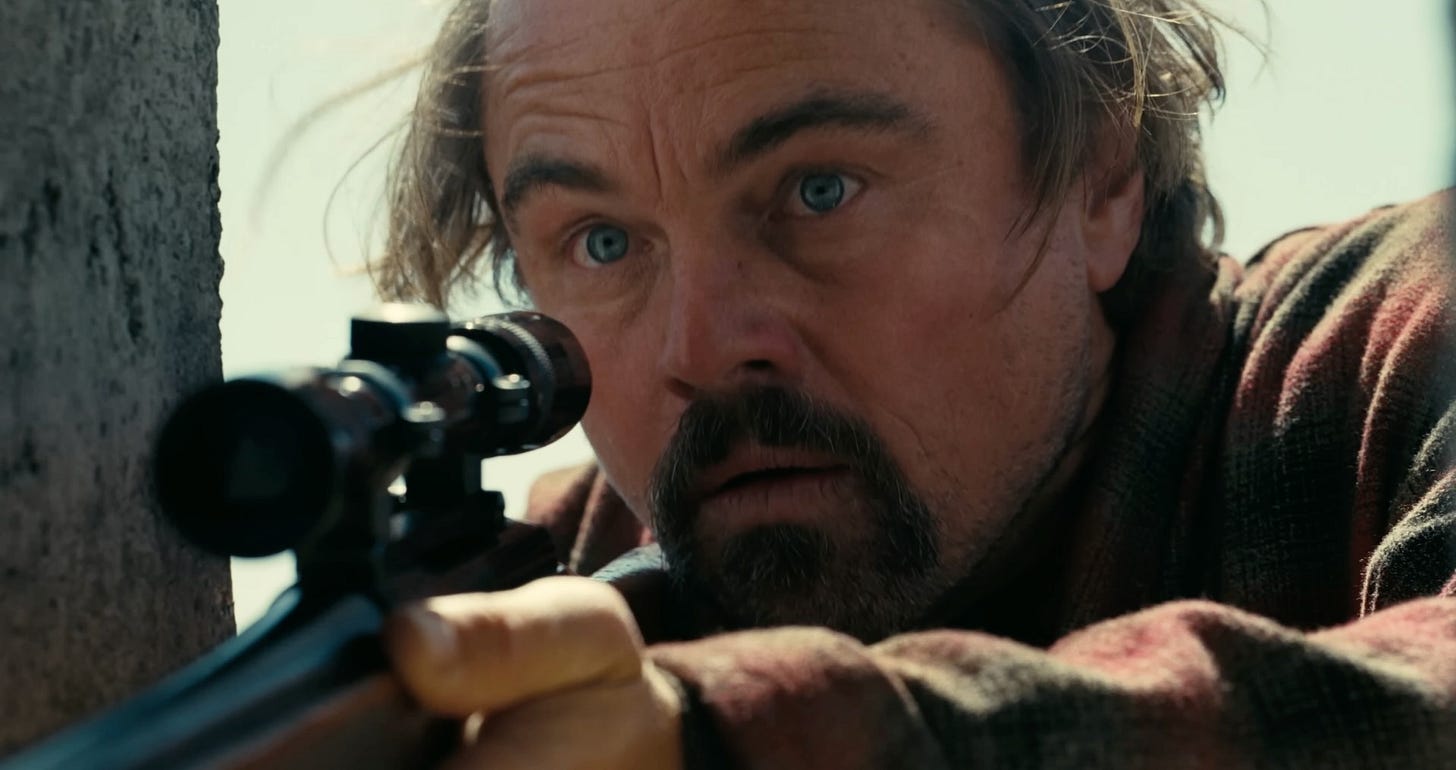Review: "One Battle After Another" finds hope, humor, and solidarity in the struggle
PTA's latest is blisteringly intense and surprisingly sweet
Paul Thomas Anderson is probably the greatest American filmmaker to emerge during my lifetime, and it is not a coincidence that nobody’s work is harder to review after just one viewing. He does not make films that lend themselves towards simple, coherently unified reactions, and he creates less for the here and now than for the sweep of future film history. His works unfold and reveal themselves with time, and they can change quite profoundly with age and life experience. One Battle After Another may be a major Warner Bros. release that cost more than his last four films combined, and it may be playing nationwide in IMAX venues at the tail end of summer instead of trickling out across the country during awards season, but it is no less resistant to quick off-the-cuff reactions than anything else he’s made.
That becomes apparent from the opening moments, as the film begins with a half-hour prologue that is aggressively kaleidoscopic, telling the story of a modern-day revolutionary leader named Perfidia Beverly Hills1 in rapid, ersatz, and somewhat impressionistic fashion. The sequence begins with images of a resistance raid on an immigration detention facility, and climaxes with violent suppression of rebels amid a wholesale collapse of Perfidia’s moral compass. Yet for all the political immediacy on display, what Anderson is actually interested in as a filmmaker is the way we can come to know a person without knowing them at all: how one can spend years loving, fighting alongside, and building a life with another human without ever fully comprehending the inner workings of their mind or heart. It is a towering short film about the distance between intimacy and perception, positioned as the opening salvo of a nearly three-hour epic that becomes towering in entirely different ways.
Anderson’s films have always spoken to the moments in which they were made: 2007’s There Will Be Blood depicted greed, power, and abuse in ways that are indelibly linked to the America of the early aughts, up to and including its characterization of oil as an almost supernaturally corrupting force, a 2001-style monolith but for animating mankind’s worst instincts; 2012’s The Master spoke to the alienation of troubled young men and the dangerous allure of charismatic cult leaders at the outset of a decade that would come to be defined by those dynamics; and to varying degrees, Anderson’s many stories of missed or tortured connection – Punch-Drunk Love, Inherent Vice, Phantom Thread, etc. – feel inseparable from the periods of widespread corruption, distrust, and uncertainty from which they emerged.
But where those films touched on contemporary anxieties more obliquely, through layers of period dress or tonal and emotional commentary, One Battle After Another is unusually direct for Anderson. It is about the America of 2025, unambiguously highlighting the state-led torment of immigrants and the re-emergence of explicit white supremacist politics as animating forces of resistance, solidarity, and political violence. In a world where corporations are bending to Donald Trump’s authoritarian impulses left and right, and blanching at anything that might upset the fascists in power – just this week, Apple TV indefinitely postponed the imminent release of The Savant, a TV series starring Jessica Chastain as an investigator infiltrating online hate groups – Warner Bros. probably deserves a modicum of credit for moving forward with the release of One Battle After Another at all. The film does not glorify or celebrate the Weather Underground-style domestic terrorism its characters engage in, but neither does it outright condemn violent resistance in a context of abusive state repression. In many of its most poignant moments, in fact, the film is a veritable ode to grassroots acts of solidarity, its story woven with countless little grace notes of people in a targeted underclass looking out for one another as the state sticks its boot in their faces. Benicio del Toro, third-billed behind Leonardo DiCaprio and Sean Penn, spends the entirety of his screentime arranging escape routes for targeted immigrants and helping DiCaprio’s character reinvigorate his atrophied revolutionary muscles. As I was heading into the theater today, Donald Trump directed his jackbooted thugs to invade Portland to ‘protect’ ICE camps from protestors, and encouraged them to use “full force” on those who would oppose his regime. Neither the evils nor the responses One Battle After Another depicts are hypothetical, and the film very definitively picks a side. It won’t be setting attendance records, but the mere fact One Battle After Another is going to open #1 at the box office for the last weekend of the September we’ve all just lived through is the kind of cultural confluence that will one day be written about in film history texts.
And yet, as with the Prologue sequence, the finger-on-the-pulse nature of the film’s storytelling may be a bit of a red herring from the ultimate thematic punches Anderson delivers. If that opening section is about the way we perceive (or fail to perceive) the complicated interiority of a loved one, the remainder of the film is ultimately rooted, above all else, in the anxieties of parenthood. That is a topic that’s surely animated Anderson’s day-to-day life for years now – he and his partner, Maya Rudolph, have four children together – but One Battle After Another is the first time it feels like parental identity has come to the forefront of his cinematic storytelling. This is the best use any filmmaker has made of Leonardo DiCaprio in quite some time, and it is because Anderson asks him to summon all the affectations and nervous energy that have increasingly defined his performance style, and channel them into the body of a father whose entire axis of gravity has been shifted by love for his daughter (a character played, to absolutely star-making effect, by newcomer Chase Infiniti). DiCaprio’s Bob (aka Pat, aka ‘Ghetto’ Pat) is a deeply flawed human, and he knows it: he was a reasonably effective revolutionary explosives expert, but he mostly followed Perfidia’s lead, and after her betrayal and abandonment, he’s missed his moment, barely hanging on as a paranoid dad who smokes too much weed. But he has one unifying purpose, and he will prioritize everything else on earth, including his own myriad shortcomings, beneath showing up for his kid. He is not a capital-h Hero, but in his basic devotion to the singular purpose of fatherhood, he is, in his own small way, heroic.
One Battle After Another does not necessarily conclude that parental love stands in opposition to revolutionary fervor, but it does potently express the way one’s horizons are irrevocably changed by becoming a parent, and how the immediacy of a daily political struggle can become secondary to making sure one’s child is able to live in the broken world they’ve inherited. Ghetto Pat never won his fight, and he probably never would have even if Perfidia had stayed resolute and kept giving him targets to bomb. But the fight is never over. The war will never be won. The struggle is, indeed, one battle after another, and as a dad, Pat’s ultimate role is to make sure his kid has the tools to fight. By the end of the film, it’s clear he has, at least, succeeded on that account: his daughter can survive this world, and she’ll probably affect more positive change in it than he ever could. Revolution is not an individual act, nor is it constrained to a single lifetime. On some level, that truth is depressing; the magic of One Battle After Another lies in refusing the nihilism, and choosing instead to see the profound hope at the heart of that acknowledgment.
In many ways, One Battle After Another plays like the ur-Paul Thomas Anderson film: it has the ensemble sprawl of his 90s Robert Altman riffs; the epic scope and register of There Will Be Blood or The Master; the paranoid stoner comedy of Inherent Vice; and a killer score from longtime collaborator Johnny Greenwood that has the same relentless intensity as Jon Biron’s work on Punch-Drunk Love, turning the entire film into an extended, non-stop panic attack. On the level of craft, the production is uniformly immaculate, with the crystal clear yet gorgeously textured VistaVision photography playing to outstanding effect on an IMAX screen. I don’t know if I entirely embrace the “this is an action movie” framing seen in other reviews – One Battle After Another is, like all of Anderson’s films, irreducible to a single genre, and it’s got as much comedy in it as anything else – but there is a car chase near the end that is absolutely one of the best such action set pieces I’ve ever seen, in part because it is so ingeniously simple in its staging and presentation. Every performance is great, including Sean Penn’s turn as one of the century’s most disgusting screen villains, Col. Steven J. Lockjaw. Both Penn and his makeup and hair artists seem to have been directed to make the character a combination of Robert F. Kennedy Jr. – perhaps the most viscerally disgusting villain in contemporary American politics – and an evil, nightmare spin on Robin Williams’ live-action Popeye portrayal (from the Robert Altman movie Anderson has paid loving homage to before). Everything about this man is wrong, and every second he spends on screen is disquieting.
All of which is to say that despite the massive budget and the IMAX release, Paul Thomas Anderson did not make a sudden pivot towards conventional Hollywood studio filmmaking: a Hollywood studio made a pivot towards Paul Thomas Anderson, and he delivered them a no-holds-barred Paul Thomas Anderson movie, top to bottom.
That One Battle After Another is likely the best film of 2025 thus far almost goes without saying, and not just because 2025 has been a fairly lightweight year for cinema overall. But I do think the film exists on a continuum with my other favorites from the past nine months – Sinners, 28 Years Later, Superman, and The Long Walk, to name a few – in how it feels so very much of the moment, emotionally and/or politically. These are films from directors with very distinct backgrounds, each channeling their differing commercial instincts to make films that feel ‘finger-on-the-pulse,’ aimed at a mass audience with the goal of starting a big conversation, all without sacrificing their individual idiosyncrasies as artists and storytellers. When I assemble my eventual Top 10 in December, there may not be a ton of films worth mentioning outside that selected group, but I am guessing those 10 will tell a very clear story about this awful year we lived and suffered through. One Battle After Another might be the best in no small part because, through all the tension and stress and fear, it so beautifully emphasizes how we only survive moments like these together. We do not live on through so many successive battles and hardships individually; we do it as a collective, and through our individual faults, we make each other better. Maybe that’s what hope actually looks like right now.
Read the book 200 Reviews by Jonathan R. Lack in Paperback or on Kindle
Subscribe to PURELY ACADEMIC, our monthly variety podcast about movies, video games, TV, and more
Like anime? Listen to the podcast I host with Sean Chapman, JAPANIMATION STATION, where we review all sorts of anime every week. Watch on YouTube or Subscribe wherever you get your podcasts.
Anderson does not use the actual names from the Thomas Pynchon book he’s loosely adapting – 1990’s Vineland – but he absolutely uses the style of names one might find in a Pynchon novel, and god bless him for it.






